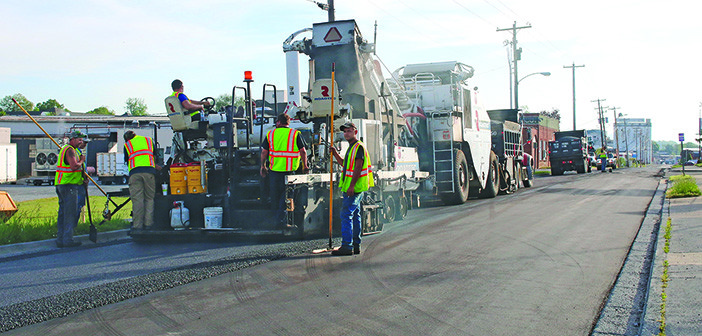By Jeff Keeling
The distinctive odor of fresh asphalt rose from the surface of West Walnut Street Friday as crews from Summers-Taylor completed resurfacing on 0.85 miles of road between Buffalo Street and University Parkway.
As foreman Doug Cox oversaw the job, “screw man” Chris Nickerson rode along the back of a giant RoadTec machine, checking the depth of the topcoat layer and adjusting on the fly if necessary. The crew’s work mirrored similar jobs that have occurred much more frequently in the fiscal year that started last July 1. Last June, the City Commission more than doubled the annual resurfacing budget, dedicating 10 cents ($1.7 million annually) of a 25-cent property tax increase to roads.
Then vice-mayor Clayton Stout, who is now mayor, provided the margin in the 3-2 vote that resulted in the city’s first property tax increase since 2002. Stout threw his support behind an increase after voting against one in 2014 largely because of the attention that he believed needed to be paid to the city’s street infrastructure.
Ten months into the new paving schedule, Stout called it “a smart decision.”
“I’ve heard lots of positive feedback from citizens about the road paving,” Stout said. “They’re glad it’s finally being done in a timely manner.”
Stout said he took heed as the city’s assistant director of public works in charge of streets, Mike Arsenault, explained the perils of allowing what’s called the “Overall Condition Index” (OCI) of many city’s streets to deteriorate. When streets reach levels below a certain point, repaving them tends to cost more than it does if a better schedule is maintained.
“There’s not a lot of flash and boom behind it, but it was something that was definitely needed,” Stout said. “If we didn’t have that injection of revenue, there’s no way we could have done half of what we have this year, and that just pushes everything even further behind.”

Summers-Taylor foreman Doug Cox, left, and screw man Chris Nickerson operate on West Walnut Street Friday. Photos by Jeff Keeling
Arsenault said he and his staff are “just pleased, I’m not sure how else to phrase it.
“We appreciate the commitment the city commission has made to help us preserve and maintain our transportation network.”
The city is on track to complete the roughly eight miles of streets it set out to at the beginning of the fiscal year, which ends June 30, Arsenault said. Work has been completed in Tunbridge subdivision off of Cherokee Road, Carter Sells, McKinley and L.P. Auer roads off of West Walnut Street, and the Pine Ridge subdivision and S. Westwood-Gray neighborhood. South Roan Street, Silverdale Road, Forest Acres Drive, Antioch Road and West Walnut also are complete.
Before June 30, crews will pave many of the streets in the Towne Acres neighborhood as well as Perma-R-Road and a portion of West Walnut west of State of Franklin Road. Fiscal 2017 neighborhood street projections call for resurfacing the remainder of Towne Acres, the Martindale, Oak Park and North Hills subdivisions, the Gump Addition and the Miller-Carr neighborhood (the area around Wilson Avenue). A list of planned arterial, feeder and collector streets through FY 2018 is at jcnewsandneighbor.com/roadslist.
“This is investment in infrastructure that is used by all the citizens as well as people that travel here, and it’s important,” he said. “We had kind of gotten behind. I think everyone recognized that.”
The commissioner who saw roads deteriorate longer than any of his peers is Jeff Banyas, who was first elected to the commission in 2007. Banyas said the uptick in resurfacing this year has been a positive, but he said there is another important component to consider: road maintenance.
While the city contracts for resurfacing, in-house public works crews perform patching and other repairs, including fixing streets after utility cuts. Banyas said he believes the pace of repair work also needs to increase, and that the commission is contemplating additional labor resources for public works in the fiscal 2017 budget.
“We probably need a couple of full time road crews out, or more,” Banyas said, adding that currently it is his understanding just one crew focuses on road repairs. “The roads have deteriorated more the past two years than they did prior to that,” he said, noting that a number of hard freezes are partly to blame.
“There are probably 10,000 potholes in Johnson City,” Banyas said.
Though he suspects the quality of asphalt has deteriorated in recent years as well, shortening the useful life of roads before repaving is needed, Banyas said additional repair work could go a long way.
“There’s a lot of stuff you can do that would really improve the quality of a road short of resurfacing,” he said. “I think that they (city staff) are addressing it. It’s just not easy.”





